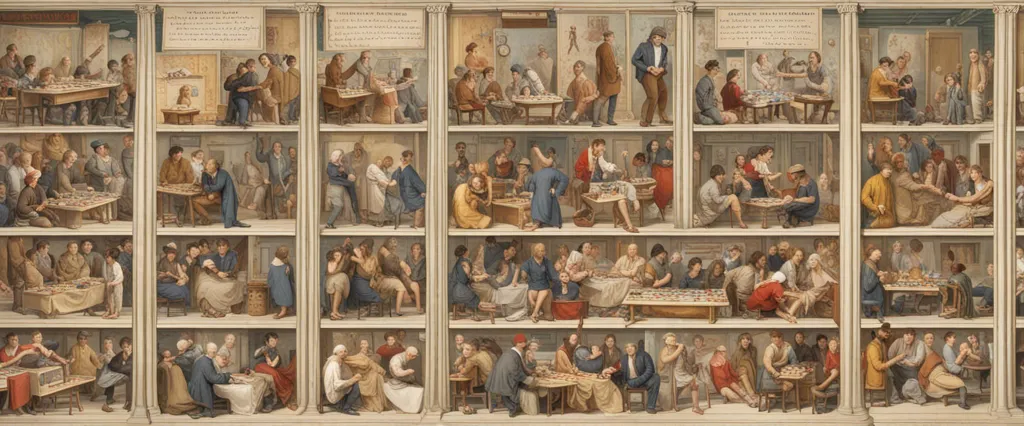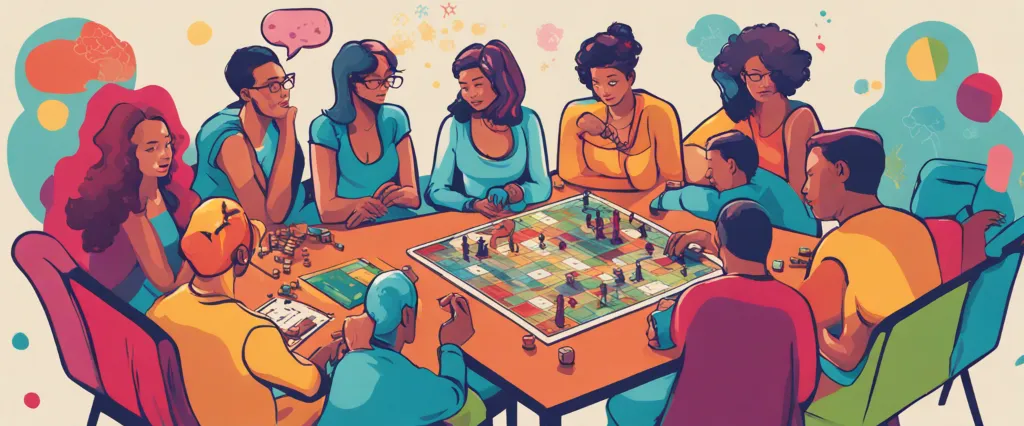In “Games People Play,” Eric Berne reveals the complex nature of human interactions through the lens of transactional analysis. Published in 1964, this seminal work prompted a revolutionary shift in the field of psychology and garnered widespread acclaim for its insightful examination of social dynamics. Drawing upon his extensive background as a psychiatrist and psychoanalyst, Berne dissects the various games people play in their day-to-day lives, shedding light on the hidden patterns of manipulation, power struggles, and hidden agendas that often dictate our behaviors. With his deep understanding of the human psyche, Berne offers readers a transformative perspective on the intricacies of human relationships, laying the foundation for a more meaningful and authentic way of engaging with others.
Chapter 1: Introduction to Transactional Analysis – Explaining the basic concepts and principles of transactional analysis.
Chapter 1 of “Games People Play” by Eric Berne introduces the readers to the basic concepts and principles of transactional analysis. Berne’s focus is on understanding the dynamics of interpersonal interactions and how individuals communicate with each other.
Berne begins by discussing the concept of “transaction,” which refers to any interaction or communication between individuals. He emphasizes that these transactions can be verbal or non-verbal and occur on different levels, including the social level (superficial exchanges) and the psychological level (true thoughts and feelings).
The author introduces the idea of “strokes,” which are units of recognition or attention that individuals give and receive during transactions. Strokes can be positive or negative, and their quantity and quality greatly influence our self-esteem and sense of worth.
Berne also highlights the role of “ego states” in transactional analysis. Ego states are essentially different aspects of an individual’s personality that influence behavior and responses during interactions. He categorizes ego states into three main types: Parent, Adult, and Child.
The Parent ego state encompasses learned behaviors and attitudes from authority figures in one’s life. The Adult ego state represents rational thinking and problem-solving. The Child ego state represents emotions and learned behaviors from childhood.
Berne explains that individuals can switch between these ego states during transactions, and understanding which ego state is dominant can help in analyzing and improving interpersonal dynamics.
In conclusion, Chapter 1 of “Games People Play” introduces readers to the fundamental concepts of transactional analysis, including transactions, strokes, and ego states. By exploring these concepts, individuals can gain valuable insights into their own interactions and improve their communication skills in various social settings.
Chapter 2: The Psychological Games We Play – Identifying the common psychological games people engage in and their underlying motivations.
Chapter 2 of “Games People Play” by Eric Berne focuses on identifying the common psychological games that people engage in and examining their underlying motivations.
Berne begins by highlighting how games are a fundamental part of human interaction, often serving as a social lubricant and providing a way to establish and maintain relationships. However, he asserts that the motivations behind playing games are not always positive or healthy.
Throughout the chapter, Berne introduces various psychological games that individuals play, offering insights into the motivations driving these behaviors. He explores games such as “If It Weren’t for You,” where individuals blame their problems on others, “See What You Made Me Do,” where individuals manipulate situations to make others feel guilty or responsible, and the “Ain’t It Awful” game, where individuals engage in a battle of one-upmanship regarding life’s misfortunes.
Berne emphasizes the role that these games play in reinforcing negative patterns of behavior and facilitating unproductive transactions between individuals. He argues that people often learn these games in childhood and continue to play them as adults, perpetuating harmful dynamics in their relationships.
Overall, Chapter 2 serves as a comprehensive overview of the psychological games people engage in, shedding light on their underlying motivations. Berne’s intention is to enable readers to recognize these games in their own lives and make conscious efforts to break free from destructive patterns of behavior. By understanding the underlying motivations, individuals can work towards healthier and more authentic interactions, leading to more fulfilling relationships.
Chapter 3: The Roles We Assume – Examining the different roles individuals adopt in social interactions and their impact on relationships.
In Chapter 3 of “Games People Play” by Eric Berne, the focus is on examining the various roles individuals adopt in their social interactions and the impact these roles have on their relationships. Berne highlights the significance of understanding these roles and how they contribute to the psychological dynamics of human interactions.
Berne introduces the concept of “transactional analysis” which acts as a tool for understanding individual roles and their effect on communication patterns. He identifies three primary ego states: the Parent, the Adult, and the Child. These ego states represent different dimensions of the roles people assume in their interactions.
First, Berne explains the role of the Parent ego state, which includes the internalized attitudes, values, and behaviors that individuals have acquired from their own parents or authority figures. This role can be nurturing or controlling, leading to various types of interactions depending on the other person’s ego state.
Next, Berne describes the Adult ego state, which encompasses rational thoughts and actions. This role is objective, logical, and based on the present circumstances, facilitating effective communication and problem-solving.
Lastly, Berne discusses the role of the Child ego state, which encompasses emotional and instinctual responses. Participants in an interaction may display a more submissive or rebellious Child, leading to varying responses from the other person involved.
Understanding these different roles and their corresponding ego states can help individuals identify and evaluate patterns in their relationships. By recognizing the ego states in themselves and others, people can gain insight into the motivations behind their actions and reactions, allowing them to improve communication and develop healthier relationships.
Overall, Chapter 3 of “Games People Play” explores the different roles individuals adopt in social interactions and sheds light on the impact of these roles on relationships. Through transactional analysis, Berne provides a framework for understanding and improving human communication dynamics.
Chapter 4: The Drama Triangle – Exploring the dynamics of the “victim,” “persecutor,” and “rescuer” roles in interpersonal conflicts.

Chapter 4 of Eric Berne’s book, Games People Play, discusses the Drama Triangle and explores the dynamics of the “victim,” “persecutor,” and “rescuer” roles in interpersonal conflicts.
The Drama Triangle is a concept that explains how individuals unconsciously adopt one of three roles when faced with conflicts or problems: the victim, the persecutor, or the rescuer. Berne suggests that these roles are played out in various situations, fueling drama and dysfunction in relationships.
The victim role involves portraying oneself as helpless, oppressed, or unfairly treated. Victims seek sympathy and often use guilt manipulation to gain attention and control. They tend to avoid taking responsibility for their own actions and rely on others to rescue them.
The persecutor role is assumed by those who blame, criticize, or attack others. Persecutors often feel righteous in their actions and project their frustrations onto someone else. They tend to exert power and control over the victim, blaming them for their own problems.
The rescuer role is taken on by those who feel the need to fix or save others from their difficulties. Rescuers may genuinely want to help, but they often enable the victim’s dependency by preventing them from experiencing the natural consequences of their actions. Rescuers may also have a hidden motive, seeking validation and a sense of superiority through their actions.
Berne explains that these roles are not fixed and can shift between individuals or even within the same person over time. The Drama Triangle perpetuates dysfunction as each role feeds off the others, creating a vicious cycle of conflict.
Understanding the Drama Triangle is crucial for individuals to break free from repetitive and destructive patterns of behavior. Berne encourages individuals to challenge their own assumptions and take responsibility for their actions. By recognizing and addressing these roles, individuals can move towards healthier and more authentic relationships.
Chapter 5: Life Scripts – Analyzing the formation of life scripts and their influence on behavior and decision-making.
Chapter 5 of “Games People Play” by Eric Berne focuses on life scripts, which are the predetermined patterns of behavior and decision-making that individuals adopt based on their early life experiences. Berne argues that these scripts heavily influence our lives, determining how we approach relationships, work, and other aspects of life.
The chapter begins by explaining that life scripts are formed early in childhood, as individuals observe and internalize the behaviors and attitudes of their primary caregivers. These caregivers act as “Parent” figures, shaping the child’s perception of the world and themselves. Berne suggests that these scripts guide individuals throughout their lives, often leading to self-fulfilling prophecies.
According to Berne, life scripts consist of a series of key decisions that individuals make early in life regarding their identity and how they should behave. These decisions include beliefs about their worthiness, loveability, and capacity for success. For example, someone with a negative script may feel unworthy of love and success, leading them to engage in self-sabotaging behaviors.
Berne emphasizes that life scripts are influential in shaping our social interactions. He describes how our scripts interact with those of others and how certain patterns of behavior arise from these interactions, leading to interpersonal games. These games are repetitive and subconscious patterns of behavior where individuals unconsciously play out their life scripts, often reinforcing negative beliefs and repeating destructive patterns.
In this chapter, Berne highlights the importance of recognizing and analyzing our life scripts in order to gain insight into our own behavior and make conscious choices that deviate from the script. He suggests that by understanding and challenging our scripts, we can break free from self-destructive patterns and create more fulfilling lives.
Overall, Chapter 5 of “Games People Play” delves into the formation and influence of life scripts, emphasizing their impact on behavior and decision-making. It encourages readers to reflect on their own scripts and consider how they can consciously shape their lives outside the confines of these predetermined patterns.
Chapter 6: Games in Intimate Relationships – Investigating the games played in romantic relationships and their effects on intimacy.
Chapter 6 of “Games People Play” by Eric Berne explores the various games played in romantic relationships and their impact on intimacy. The author describes these games as repetitive patterns of interaction that individuals engage in, often without conscious awareness, to fulfill certain psychological needs.
Berne begins by discussing the popular game of “Why Don’t You – Yes, But,” which demonstrates the dynamic of seeking help or advice while simultaneously blocking any potential solutions. This game serves to reinforce the players’ belief that they are helpless and cannot escape their problems, thereby avoiding responsibility for their actions.
The chapter also delves into the game of “If It Weren’t for You,” highlighting how individuals blame their partners for their own unhappiness and failures. By shifting blame, they can maintain a victim mentality and avoid taking responsibility for their own lives.
Berne also introduces the game of “See What You Made Me Do,” where individuals use their partner’s negative behavior to justify their own outbursts or mistreatment. This game works to maintain a power dynamic where one person controls the other through guilt or manipulation.
Furthermore, the author explores the game of “Ain’t It Awful,” which involves finding faults and complaining about external circumstances while seeking sympathy. This game serves to evoke pity and attention from others, maintaining a sense of significance and avoiding personal growth.
Lastly, Berne discusses the game of “Now I’ve Got You, You Son of a Bitch,” where individuals create an escalating conflict to test their partner’s commitment and loyalty. This game fuels drama and provides a sense of excitement, allowing individuals to avoid boredom and resort to destructive behavior to maintain passion in the relationship.
Overall, Berne highlights that these games hinder genuine intimacy, as they prevent individuals from recognizing their own vulnerabilities and addressing their underlying psychological needs. By becoming aware of these games and taking responsibility for their behavior, individuals can begin to establish healthier and more authentic connections in their romantic relationships.
Chapter 7: Games at Work – Discussing the games that occur in professional settings and their impact on productivity and morale.
Chapter 7 of “Games People Play” by Eric Berne, titled “Games at Work,” delves into the intricate dynamics of games that occur in professional settings and their effects on productivity and morale.
Berne begins by illustrating how games can be found in various workplace scenarios, such as office politics, power struggles, and bureaucratic hierarchies. He emphasizes that these games serve as a means for individuals to avoid confronting their true intentions or engaging in genuine interactions. Instead, they engage in subtle maneuvers to achieve personal goals or to protect their self-image.
The chapter explores different games played in the workplace, detailing their underlying motivations and consequences. For example, the “Yes… But” game demonstrates how individuals use an initial agreement as a setup to decline or refute any proposed solution. This game allows the player to maintain a sense of superiority while avoiding responsibility or risking failure. Other games, such as “Gotcha!” and “Uproar,” expose the manipulative tactics employed to undermine colleagues or maintain control within a team or organization.
Berne also examines the impact of these workplace games on productivity and morale. He argues that games hinder authentic collaboration and hinder collective progress. Instead of focusing on the task at hand, individuals become preoccupied with winning personal battles or defending their status.
In conclusion, Chapter 7 sheds light on the various games played within professional contexts and emphasizes their detrimental effects on workplace dynamics. Berne emphasizes the importance of recognizing and understanding these games to improve productivity, foster genuine relationships, and create a healthier work environment.

Chapter 8: Breaking Free from Games – Providing strategies for recognizing and breaking free from destructive patterns of gameplay.
Chapter 8 of “Games People Play” by Eric Berne focuses on the strategies for recognizing and breaking free from destructive patterns of gameplay. In this chapter, Berne delves into the concept of games and dives deeper into how individuals can break free from unhealthy patterns.
Berne begins by discussing the importance of identifying and understanding the unconscious motivations behind engaging in certain games. He emphasizes that recognizing one’s own role in perpetuating these destructive patterns is essential for starting the process of change. By becoming aware of these games and the underlying reasons for their appeal, individuals can begin to detach themselves from the destructive cycle.
Berne provides a series of strategies to aid in breaking free from games. Firstly, he suggests developing a language to express one’s feelings and desires directly, rather than resorting to game-playing as a means of communication. By fostering open and honest dialogue, individuals can create an atmosphere where games are less likely to thrive.
Secondly, Berne encourages individuals to take responsibility for their actions and decisions. By acknowledging personal agency, one can stop playing the victim role and regain control over their life. This involves setting clear boundaries, making conscious choices, and actively pursuing personal goals.
Lastly, the chapter stresses the importance of seeking professional help, especially when dealing with deeply embedded game dynamics. Berne emphasizes the role of psychotherapy in illuminating these unconscious patterns and providing guidance for change.
Overall, Chapter 8 of “Games People Play” provides strategies for individuals to recognize the games they engage in, understand their motivations, and break free from destructive gameplay patterns. By developing effective communication skills, taking responsibility for one’s actions, and seeking professional support when needed, individuals can work towards healthier and more fulfilling relationships.
After Reading
In conclusion, Eric Berne’s book “Games People Play” offers a fascinating exploration of human behavior and the various psychological games that people engage in. Through his analysis of common interpersonal interactions, Berne sheds light on the underlying motives, hidden agendas, and manipulative tactics that often take place in our everyday lives. By identifying these games and understanding their dynamics, readers are empowered to recognize and break free from destructive patterns, leading to healthier, more authentic relationships. With its insightful concepts and thought-provoking examples, “Games People Play” serves as a valuable guide for anyone seeking to navigate the complex world of human interactions.
1. “Manipulation: The Art of Influencing People” by Daniel Smith – This book explores the various psychological techniques individuals use to influence others and gain control over situations. It delves into the different tactics employed in social interactions, providing an insightful understanding of human behavior.
2. Influence: The Psychology of Persuasion” by Robert Cialdini – Similar to “Games People Play,” this book delves into the realm of persuasion and manipulation. It explores six key principles of influence, such as reciprocity, authority, and social proof, offering valuable insights into the strategies people employ to sway others and navigate social dynamics.
3. The Art of Thinking Clearly” by Rolf Dobelli – This book focuses on the fallacies and biases that contaminate human reasoning and decision-making. It highlights the cognitive traps that individuals fall into, helping readers to identify these cognitive errors and make more rational choices in their personal and professional lives.
4. Emotional Intelligence: Why It Can Matter More Than IQ” by Daniel Goleman – Expanding on the importance of emotional intelligence, this book deepens our understanding of how emotions influence our relationships and interactions. It provides valuable insights into recognizing and managing emotions in ourselves and others, which is an essential aspect of the complex dynamics explored in “Games People Play.”
5. “The Sociopath Next Door” by Martha Stout – This chilling book explores the presence of sociopaths in society and their ability to manipulate and deceive those around them. It offers an intriguing glimpse into the dark side of human behavior, making it a captivating read for those interested in the interpersonal struggles and games discussed in Eric Berne’s work.




